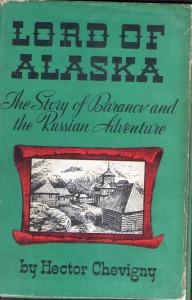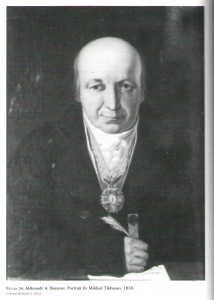 Reading the book “Lord of Alaska” by Hector Chevigny about Alexander Andreyevich Baranov, the first Governor of the Russian America (1799-1818), it became interesting what this name did come from. “Russian America” was the name of Russian colonial possessions in the Americas from 1733 to 1867 that today is the US state of Alaska and settlements farther south in California. Formal incorporation of the possessions did not take place until a ukase ( a proclamaition or decree of the tsar) in 1799, which established a monopoly for the Russian-American Company, and also granted the Russian Orthodox Church certain rights in the new possessions.
Reading the book “Lord of Alaska” by Hector Chevigny about Alexander Andreyevich Baranov, the first Governor of the Russian America (1799-1818), it became interesting what this name did come from. “Russian America” was the name of Russian colonial possessions in the Americas from 1733 to 1867 that today is the US state of Alaska and settlements farther south in California. Formal incorporation of the possessions did not take place until a ukase ( a proclamaition or decree of the tsar) in 1799, which established a monopoly for the Russian-American Company, and also granted the Russian Orthodox Church certain rights in the new possessions.
The capital of the Russian America was New Archangel which is now in the area of Sitka. So, the political structure was colony, there spoken languages were: Russian, Haida, Tsim ashianic, Eskimo-Aleut, Chinook Jargon, Na-Dene.
From the geography, even just looking at the map, we can see that Bering Strait is so close between Russia’s East coast and Alaska’s west coast. Travelling this summer around Alaska we did not sail so far to that Bering Strait, but even from the inside the passage we felt connected to this closeness, visiting museums, churches, through the readings: 
“The Russian-American Company” was chartered by the Emperor Paul I in 1799, to govern the Russian possessions in North America on behalf of Russian Empire. So, in 1790 Shelekhov, back in Russia, hired Alexander Andreyevich Baranov (1746-1819) to manage his Alaskan fur enterprise”.
There was an opinion at those times: they who control Alaska can control the Pacific. From 1812 to 1841 Fort Ross California was active. From 1814 to 1817 Russian Fort Elizabeth was operating in Hawaii.
In Russo-American Treaty in 1824 recognized the exclusive Russian rights to the fur trade above latitude 54°,40′ North with the American rights and claims restricted to below that line, as was also the context of the Treaty of Saint Petersburg, a parallel agreement with the British in 1825.
The agreements soon went by the wayside, however, and with the retirement of Alexander Baranov in 1818, the Russian hold on Alaska was weakened.
 By the 1860s, the Russian Government was considering ridding itself of its Russian America colony. Zealous over-hunting had severely reduced the fur-bearing animal population, and competition from the British and Americans exacerbated the situation. This, combined with the difficulties of supplying and protecting such a distant colony, brought about a waning interest.
By the 1860s, the Russian Government was considering ridding itself of its Russian America colony. Zealous over-hunting had severely reduced the fur-bearing animal population, and competition from the British and Americans exacerbated the situation. This, combined with the difficulties of supplying and protecting such a distant colony, brought about a waning interest. 
After Russian America was sold to the US in 1867, for $ 7,2 million (2 cents per acre) (total: $ 120 million in today’s terms), all the holdings of the Russian-American Company were liquidated.
At the end of the book we read:
“Russia withdrew from the world’s race for maritime colonies. The despairing cry of Peter the Great that his people would never be a nation of sailors seemed justified at long last”.
Listen to the M.I.Glinka’s song: “Glory!”